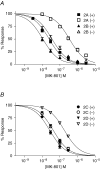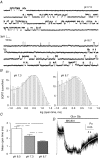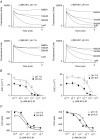Subunit-specific mechanisms and proton sensitivity of NMDA receptor channel block
- PMID: 17303642
- PMCID: PMC2075223
- DOI: 10.1113/jphysiol.2006.124958
Subunit-specific mechanisms and proton sensitivity of NMDA receptor channel block
Abstract
We have compared the potencies of structurally distinct channel blockers at recombinant NR1/NR2A, NR1/NR2B, NR1/NR2C and NR1/NR2D receptors. The IC50 values varied with stereochemistry and subunit composition, suggesting that it may be possible to design subunit-selective channel blockers. For dizocilpine (MK-801), the differential potency of MK-801 stereoisomers determined at recombinant NMDA receptors was confirmed at native receptors in vitro and in vivo. Since the proton sensor is tightly linked both structurally and functionally to channel gating, we examined whether blocking molecules that interact in the channel pore with the gating machinery can differentially sense protonation of the receptor. Blockers capable of remaining trapped in the pore during agonist unbinding showed the strongest dependence on extracellular pH, appearing more potent at acidic pH values that promote channel closure. Determination of pK(a) values for channel blockers suggests that the ionization of ketamine but not of other blockers can influence its pH-dependent potency. Kinetic modelling and single channel studies suggest that the pH-dependent block of NR1/NR2A by (-)MK-801 but not (+)MK-801 reflects an increase in the MK-801 association rate even though protons reduce channel open probability and thus MK-801 access to its binding site. Allosteric modulators that alter pH sensitivity alter the potency of MK-801, supporting the interpretation that the pH sensitivity of MK-801 binding reflects the changes at the proton sensor rather than a secondary effect of pH. These data suggest a tight coupling between the proton sensor and the ion channel gate as well as unique subunit-specific mechanisms of channel block.
Figures









Comment in
-
NMDA receptor antagonists: tools in neuroscience with promise for treating CNS pathologies.J Physiol. 2007 May 15;581(Pt 1):1-2. doi: 10.1113/jphysiol.2007.130732. Epub 2007 Mar 1. J Physiol. 2007. PMID: 17331982 Free PMC article. No abstract available.
References
-
- Albers GW, Goldberg MP, Choi DW. N-Methyl-d-aspartate antagonists: ready for clinical trial in brain ischemia? Ann Neurol. 1989;25:398–403. - PubMed
-
- Andine P, Widermark N, Axelsson R, Nyberg G, Olofsson U, Martensson E, Sandberg M. Characterization of MK-801-induced behavior as a putative rat model of psychosis. J Pharmacol Exp Ther. 1999;290:1393–1408. - PubMed
-
- Antonov SM, Gmiro VE, Johnson JW. Binding sites for permeant ions in the channel of NMDA receptors and their effects on channel block. Nat Neurosci. 1998;1:451–461. - PubMed
-
- Balster RL. Drug abuse potential evaluation in animals. Br J Addict. 1991;86:1549–1558. - PubMed
Publication types
MeSH terms
Substances
Grants and funding
LinkOut - more resources
Full Text Sources
Other Literature Sources
Molecular Biology Databases

